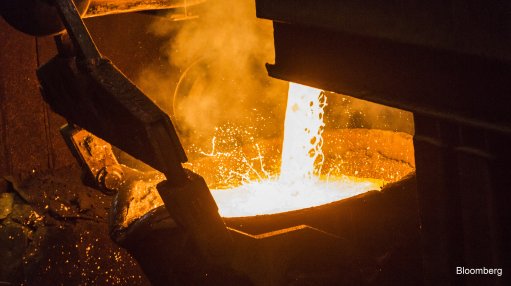China sets course for smooth economic transition and commodity price gains
TORONTO (miningweekly.com) – The retreat of commodity prices on the back of China’s economic shift belied rising levels of uptake and the likelihood of an upcycle later in the decade, CRU Group managing consultant Philip Macoun told an audience at the recent Prospectors and Developers Association of Canada convention.
However, oversupply in China continued to weigh on short- to medium-term commodity performance. “[The price slides are] not so much due to the fall in import volumes but excess supply,” Macoun said.
KEY COMMODITIES
Of 16 key commodities, CRU noted China accounted for 39% of global production and 45% of global consumption over 2014. CRU’s index of import volumes into China tracked growth back to February 2014, albeit with volatility.
Recent prices had been weighed on by supply surpassing that growth in demand, with the decline in China’s domestic commodity prices – down 30% from 2012 – a reflection of this.
CRU also computed the decline in value of Chinese imports by comparing the top-ten commodities entering the country during January to July each year from 2013 to 2015. It estimated a fall of $150-billion.
“And that’s why the commodity countries have been so severely impacted,” Macoun said.
Shuttering capacity would add the necessary price support and enable a drawdown of excess material. However, closures have often proven harder to carry out in practise than in theory.
“Facilitation of closures is an important part of the supply side adjustment and it could help the commodity markets improve,” Macoun said. “But it’s a difficult policy to implement and the adjustment process is very painful.”
Capacity reductions had been quicker for some commodities than others. That was particularly the case for nickel and aluminium, which had witnessed substantial operational closures in China.
The speed was fastest in the private sector, where costs had often been higher or where obsolete technologies had been used. On other occasions, such as with zinc smelting, there had been environmental pressure for closures.
Further shuttering of mines, smelters, steelmakers and other processing facilities was expected. “And the social impact of that is enormous,” Macoun said. “They are going to be the same sort of readjustment and restructuring processes we once saw happen in Europe and the US.”
KING COPPER
While Chinese demand for the top-ten commodities continued to grow, the pace of that rise had slowed. For example, 2015 witnessed the slowest year-on-year rise over a decade.
CRU predicted the pace would grow once more across 2016 to 2018, before sliding back down over 2019 and 2020.
Compound annual growth rates (CAGR) for Chinese commodities estimated across 2015 to 2020 stood at 5.5% for gold; 3.7% for aluminium; 2.9% for zinc; 1.9% for copper; 1.6% for nickel; and 1.5% for lead.
By contrast, CAGR for iron and metallurgical coal were expected to decline by -0.3% and -0.5% respectively. “The slowdown is more acute for carbon steel-related metals and raw materials, with slightly better prospects for the base metals,” Macoun said.
Unsurprisingly, CAGR across 2000 to 2014 was far higher and reflected China’s economic leap during that period.
Copper’s rate of consumption had slowed significantly, with CRU estimating growth of 1.9% globally for 2016 and 2.8% specific for China. More cuts relating to copper ouput were predicted, while visible stock levels would be low.
China’s copper concentrates requirement for the next five years were anticipated to be relatively strong. “We expect China’s concentrates import requirement to rise by more than 50% by 2020,” he said. “China will become the home of most new smelting capacity for copper.”
That growth in capacity would outstrip domestic production and so feed into import demand.
Copper’s overall price outlook was to bottom out this year, before starting a gradual recovery to regain lost value over 2017. CRU estimated a deficit in copper supply would emerge in 2018/2019, with prices reaching a $6 500/t London Metal Exchange-cash price by 2019.
BRIGHTER LATER
“Like iron-ore producers everywhere, China’s miners felt pressure across 2015 as up to 50-million tonnes was squeezed out of the market. “And Chinese iron-ore miners will still be feeling pain over the next few years,” Macoun said.
Domestic output continued its sliding trend that started in 2013, with CRU estimating levels would have fallen by 300 million tonnes by 2020, albeit with a weak recovery predicted to start from around 2018.
Metallurgical coal remained in the doldrums, with prices driven below $80/t by year-end 2015. There had been a recent rally, although CRU was not confident of its sustainability as rebalancing supply and demand would take longer than previously thought.
“We’ve seen supply cuts but we think more supply displacement will be needed in 2016,” Macoun said.
Producers also needed to make sustainable cuts to operating costs beyond the advantages accrued from oil and currency devaluation against the US dollar. Otherwise they would be unable to witness improved margins on prices and costs rising.
By contrast, gold’s outlook looked brighter, improving since the start of 2016 with a notable rally. However, CRU was not bullish on gold for the medium term.
Overall, China would remain the central driver for global commodities uptake for the foreseeable future. The greatest support would come from the nation’s real estate market, which was vital for overall growth and stability.
“The property market matters far more than the equity market in China,” Macoun stressed.
CRU estimated that much of the excess housing stock produced over recent years would recede across 2016 and into 2017.
“There are a lot of inventories that need to be worked through,” he said. “CRU estimates these will be down to more normal levels by early next year and enough to justify the start of increased building activity”
The picture would be brighter by 2019 as China continued to navigate its economic transition. Supply chains that had witnessed earlier capacity retrenchment would benefit in kind.
However, Macoun also voiced a note of caution. CRU’s analysts estimated the probability of a disorderly economic transition had risen to between 20% and 35%. The chance of an orderly transition stood at 55%.
“There are some significant problems, but we think they will be managed successfully,” he added. “The outlook for commodities as China goes through these changes is for improvement.”
Comments
Press Office
Announcements
What's On
Subscribe to improve your user experience...
Option 1 (equivalent of R125 a month):
Receive a weekly copy of Creamer Media's Engineering News & Mining Weekly magazine
(print copy for those in South Africa and e-magazine for those outside of South Africa)
Receive daily email newsletters
Access to full search results
Access archive of magazine back copies
Access to Projects in Progress
Access to ONE Research Report of your choice in PDF format
Option 2 (equivalent of R375 a month):
All benefits from Option 1
PLUS
Access to Creamer Media's Research Channel Africa for ALL Research Reports, in PDF format, on various industrial and mining sectors
including Electricity; Water; Energy Transition; Hydrogen; Roads, Rail and Ports; Coal; Gold; Platinum; Battery Metals; etc.
Already a subscriber?
Forgotten your password?
Receive weekly copy of Creamer Media's Engineering News & Mining Weekly magazine (print copy for those in South Africa and e-magazine for those outside of South Africa)
➕
Recieve daily email newsletters
➕
Access to full search results
➕
Access archive of magazine back copies
➕
Access to Projects in Progress
➕
Access to ONE Research Report of your choice in PDF format
RESEARCH CHANNEL AFRICA
R4500 (equivalent of R375 a month)
SUBSCRIBEAll benefits from Option 1
➕
Access to Creamer Media's Research Channel Africa for ALL Research Reports on various industrial and mining sectors, in PDF format, including on:
Electricity
➕
Water
➕
Energy Transition
➕
Hydrogen
➕
Roads, Rail and Ports
➕
Coal
➕
Gold
➕
Platinum
➕
Battery Metals
➕
etc.
Receive all benefits from Option 1 or Option 2 delivered to numerous people at your company
➕
Multiple User names and Passwords for simultaneous log-ins
➕
Intranet integration access to all in your organisation





















